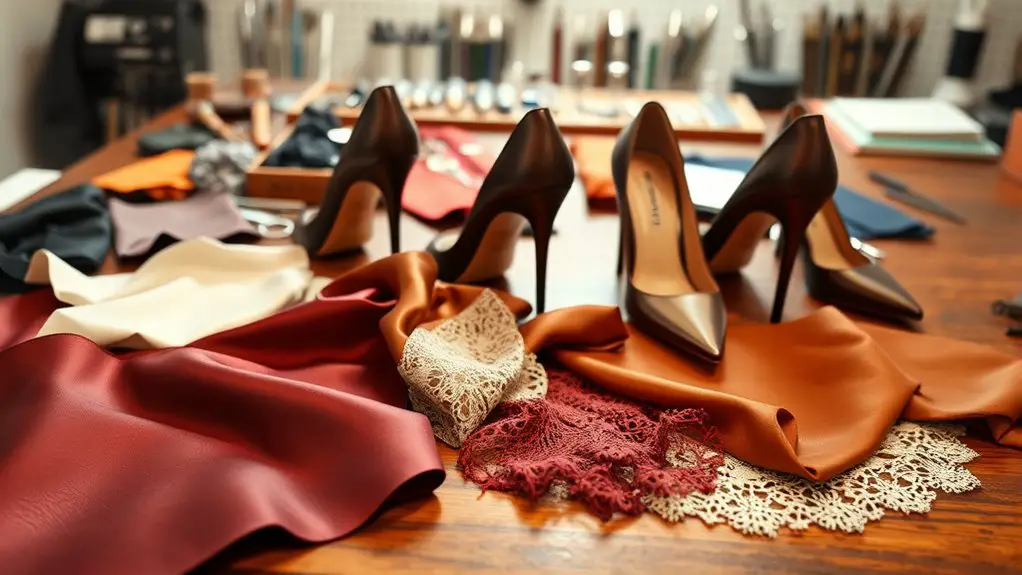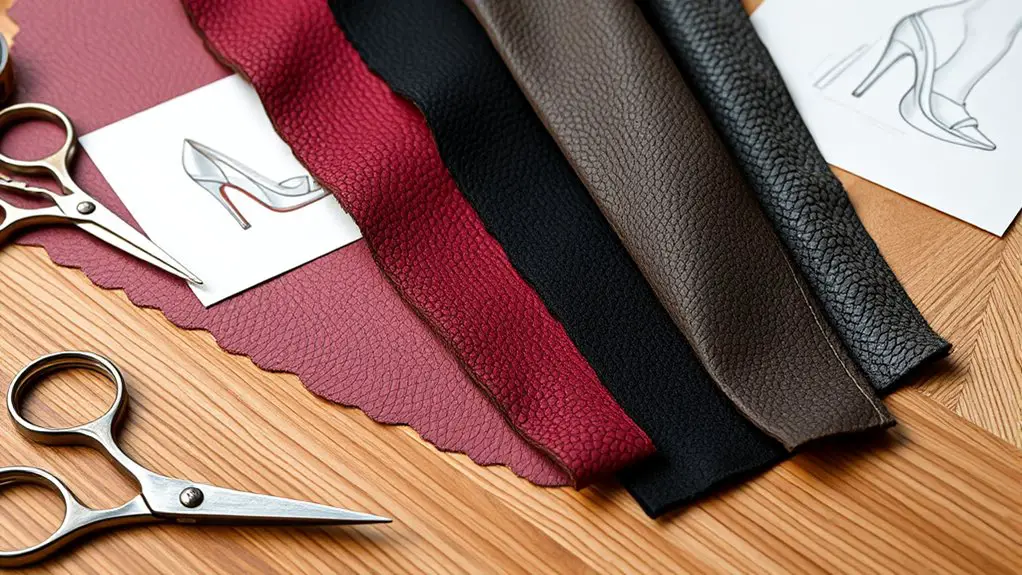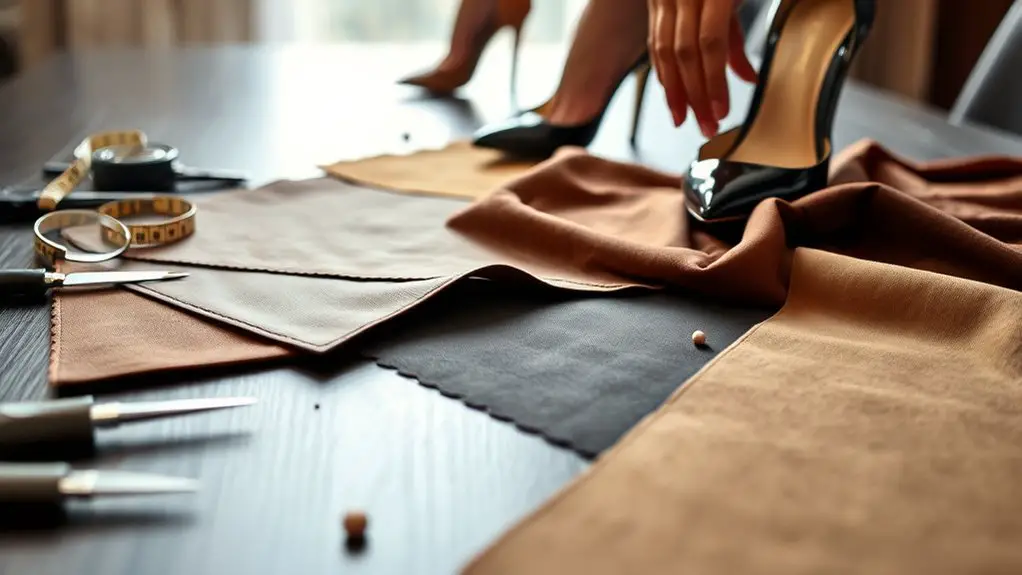When choosing materials for high heels, you’ll notice designers weigh luxury, comfort, and sustainability. Leather offers a luxurious feel but requires upkeep, while synthetic options mimic its look and are easier to maintain. The right materials guarantee a perfect fit, enhancing your style and confidence. You’ll also find that trends and innovations, like eco-friendly materials and advanced technologies, influence these choices. Discover how these elements come together to redefine high heel fashion.
The Importance of Material Selection in High Heel Design

When you slip on a pair of high heels, you might not realize that the choice of materials plays an essential role in both comfort and style. The interplay of design aesthetics and performance factors is vital in creating the perfect heel. For instance, materials like leather offer a luxurious look while providing flexibility and breathability, essential for long wear. On the other hand, synthetic options can enhance durability and resistance to wear, allowing for creative, bold designs.
Understanding how different materials interact with your foot is key; they can influence how a heel feels during movement. Cushioning within the insole can mitigate pressure points, ensuring you can strut your stuff without discomfort. Ultimately, the right material selection not only elevates visual appeal but also enhances functionality, allowing you to embrace both elegance and ease. So, as you choose your next pair, think about how material influences your heel’s overall experience.
Common Materials Used in High Heels
When choosing high heels, you’ll often find yourself weighing the benefits of leather against synthetic materials. Each option brings its own unique qualities, from durability to aesthetic appeal, while also raising important questions about sustainability. Understanding these choices will help you make informed decisions that align with your values and style.
Leather vs. Synthetic Options
While the allure of high heels often lies in their aesthetic appeal, the choice of materials—leather or synthetic—can greatly impact both comfort and durability. Leather types, like full-grain and suede, offer a luxurious feel and breathability, molding to your feet over time. However, they can be more expensive and require careful maintenance. On the other hand, synthetic blends, such as polyurethane and microfibers, provide a more affordable, water-resistant option. These materials can mimic the look of leather while often being easier to clean. Ultimately, your choice depends on your priorities: the classic elegance of leather or the practicality of synthetic options. Each material has its unique advantages, so weigh them carefully before stepping into your next pair of high heels.
Impact of Sustainability Choices
As you explore the world of high heels, the impact of sustainability choices in materials becomes increasingly significant. Designers are now prioritizing eco-friendly practices, opting for materials like recycled plastics, organic cotton, and plant-based leathers. These alternatives not only reduce environmental harm but also resonate with the growing consumer awareness about sustainable fashion.
When you slip on a pair of high heels made from innovative, sustainable materials, you’re not just making a style statement; you’re supporting a movement towards responsible consumption. By choosing brands that emphasize sustainability, you’re encouraging the industry to adopt greener practices. Ultimately, your choices matter, influencing designers to create beautiful, stylish footwear that aligns with your values and the planet’s health.
The Role of Leather in Luxury Footwear

Though many materials vie for attention in luxury footwear, leather remains the quintessential choice, embodying both elegance and durability. When you slip into a pair of high heels crafted from premium leather, you’re not just wearing shoes; you’re embracing a legacy of timeless elegance that has stood the test of fashion trends. The richness of leather provides an unparalleled luxury texture, enhancing both the aesthetic and the tactile experience of your footwear.
Leather’s natural properties allow for breathability and adaptability, molding to your foot over time for a custom fit. High-quality leather also showcases exquisite craftsmanship, with artisans often employing techniques like hand-stitching or intricate embossing to elevate the design. This attention to detail is what sets luxury heels apart, ensuring that each pair not only looks stunning but also withstands the rigors of wear. Ultimately, leather remains the gold standard in luxury footwear, marrying style with substance effortlessly.
Exploring Synthetic Alternatives: Pros and Cons
When considering synthetic materials for high heels, you’ll find a trade-off between durability and comfort that can greatly affect your wearing experience. Additionally, the environmental impact of these alternatives can’t be ignored, prompting a closer look at sustainability practices. Finally, weighing the cost-effectiveness of synthetics versus traditional materials is essential in making an informed choice that meets both your budget and style.
Durability vs. Comfort
While you might prioritize style when selecting high heels, the debate between durability and comfort can’t be ignored, especially when considering synthetic materials. Synthetic options offer a range of durability factors, such as resistance to wear and tear, which can enhance the lifespan of your footwear. However, these materials often fall short in comfort priorities, as they may lack breathability and flexibility compared to natural alternatives. You’ll want to weigh the benefits of a longer-lasting shoe against the immediate comfort it provides. High heels made from synthetic materials can sometimes compromise your foot’s natural alignment, leading to discomfort during extended wear. Ultimately, finding a balance between durability and comfort is key to enjoying your stylish choice without sacrificing your well-being.
Environmental Impact Considerations
As you explore your options for high heels, considering the environmental impact of materials is essential, especially with the rise of synthetic alternatives. While these materials offer some benefits, their eco-friendly options and recycling initiatives vary greatly.
Here’s a quick comparison to help you decide:
| Synthetic Material | Environmental Impact |
|---|---|
| PVC | Non-biodegradable, hard to recycle |
| PU | Less toxic, more recyclable |
| Recycled PET | Eco-friendly, supports recycling initiatives |
| Biodegradable options | Break down easily, minimal impact |
Cost-Effectiveness Analysis
Choosing the right material for high heels not only impacts the environment but also your wallet. A cost analysis reveals that synthetic alternatives can offer a budget-friendly option while maintaining style. Here’s what to evaluate in your material budgeting:
- Durability: Synthetic materials often resist wear and tear better than natural ones.
- Maintenance: Easier to clean and maintain, saving you time and money.
- Versatility: Available in a wide range of colors and textures, enhancing design possibilities.
- Sustainability: Some synthetics are made from recycled materials, reducing environmental impact.
- Price Point: Generally lower upfront cost compared to leather.
When weighing pros and cons, remember that quality synthetics can be both economical and stylish, making them a smart choice for your high heels.
Balancing Aesthetics and Comfort
When selecting high heels, it’s essential to strike the right balance between aesthetics and comfort, since both elements play a significant role in your overall experience. Designers face unique challenges in aligning their design priorities with consumer preferences. While you might be drawn to striking visual elements—like bold colors or intricate embellishments—these features shouldn’t compromise comfort.
Materials like soft leather or cushioned insoles can enhance your comfort without sacrificing style. Consider the heel height and arch support, as these factors can drastically affect how you feel throughout the day. Designers often experiment with different materials to create a beautiful silhouette while ensuring it feels good on your feet. Ultimately, the goal is to have high heels that not only turn heads but also allow you to walk confidently and comfortably. Remember, the right pair can elevate both your outfit and your mood.
Durability: How Material Choice Affects Longevity

While you might be tempted by the allure of trendy designs, understanding how material choice impacts durability is essential for ensuring your high heels stand the test of time. High-quality materials undergo resilience testing to assess their ability to withstand wear and tear, while also considering material aging.
Understanding material choice is crucial for high heels that combine style with lasting durability.
When selecting high heels, imagine the difference that durable materials can make:
- Soft, supple leather that molds to your foot
- Robust rubber soles that grip the ground
- Breathable fabrics that resist moisture damage
- Reinforced stitching that holds up under pressure
- Lightweight composites that reduce fatigue
Prioritizing durability means investing in heels that won’t just look great on your feet but will last through countless nights out. Always consider how your chosen materials will age over time, as this decision is key to maintaining both style and longevity in your beloved footwear.
The Impact of Trends on Material Selection
As fashion trends evolve, the materials used in high heels often shift in response, reflecting the latest styles while balancing practicality and comfort. Designers rely on trend forecasting to anticipate consumer preferences, ensuring that their creations resonate with the current market. For instance, during a resurgence of bold colors and textures, you might see innovative materials like metallic leather or synthetic blends that mimic exotic skins, providing both flair and durability.
Fashion cycles dictate not just aesthetics but also functionality, as heels must cater to lifestyle changes—think the rise of remote work leading to a demand for more comfortable designs. Material innovation plays an essential role here; advancements allow for lighter, more flexible options without compromising style. Ultimately, your choice of high heels is influenced by these trends, marrying the allure of fashion with the practical needs of everyday life.
Sustainability in High Heel Materials
Though sustainability may seem like a buzzword in the fashion industry, it’s become an essential consideration in the selection of materials for high heels. You’ll find that today’s designers prioritize eco-friendly innovations, integrating biodegradable materials that minimize environmental impact without sacrificing style. Imagine slipping into heels made from:
- Organic cotton for soft, breathable linings
- Recycled plastics that transform waste into chic designs
- Natural rubber for flexible, comfortable soles
- Plant-based leathers that mimic the look of traditional leather
- Sustainable wood for eco-conscious heels
These choices not only reflect a commitment to sustainability but also appeal to the ethically-minded consumer. By opting for these materials, you’re not just making a fashion statement; you’re supporting a movement toward a more responsible and sustainable footwear industry. It’s a win-win for both your wardrobe and the planet!
Innovations in High Heel Material Technology
The push for sustainability in high heel materials has paved the way for remarkable innovations in material technology. You’re likely to see biomaterial innovations that not only reduce environmental impact but also enhance comfort and durability. Designers are experimenting with plant-based leathers and recycled plastics, offering a chic yet eco-friendly alternative to traditional materials.
3D printing technology is revolutionizing the way high heels are produced, allowing for precise customization and minimizing waste. This technique enables you to create intricate designs that were once impossible, merging art with engineering. Imagine heels tailored specifically to your foot shape, providing unparalleled support without sacrificing style.
As these innovations continue to evolve, you’ll find a new era of high heels that blend fashion with functionality, ensuring you look good while making a positive impact on the planet. The future of high heel materials is not just about aesthetics; it’s about sustainability and performance.
Frequently Asked Questions
How Do Shoe Designers Test Material Comfort for High Heels?
When evaluating comfort, you’ll find designers conduct material testing through wear trials, reviewing flexibility and cushioning. They gather feedback on pressure points and overall feel, ensuring each high heel meets comfort evaluation standards for wearability.
What Influences the Cost of Materials for High Heels?
When considering the cost of materials for high heels, you’re influenced by sourcing challenges and market trends. Fluctuating prices and availability can greatly impact your budget, requiring careful analysis to guarantee quality and affordability.
Are There Specific Materials for Different Heel Heights?
When considering heel heights, you’re looking at material durability and heel stability. Shorter heels often use softer materials for comfort, while taller ones require firmer options to guarantee strength and balance during wear.
How Do Climate and Weather Affect Material Choice?
When it comes to materials, you’ve got to weather the storm. Climate impacts your choices; lightweight fabrics might not hold up in rain, while leather offers durability. Always consider the weather’s unpredictability before selecting your materials.
What Role Do Consumer Preferences Play in Material Selection?
Consumer preferences considerably shape material selection, as you’ll notice trends leaning towards sustainable options. Designers often prioritize eco-friendly materials, ensuring they meet consumer demand while balancing aesthetics, durability, and overall environmental impact in their creations.



